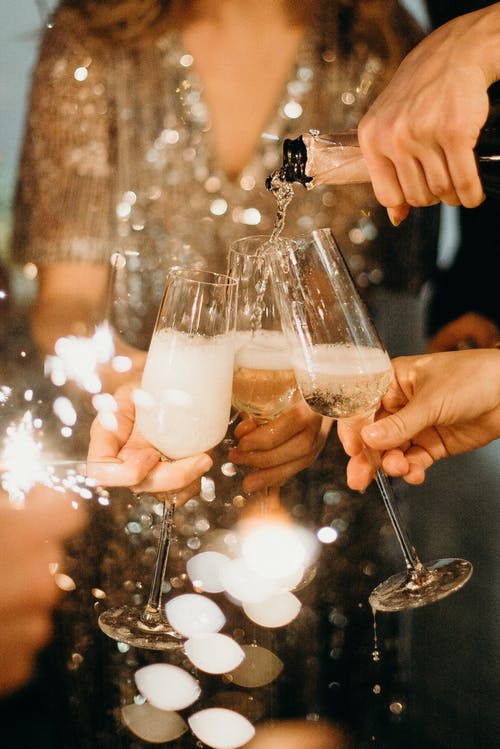Posted: Dec 27, 2019

With the pop of the cork, a cascade of bubbles and a clink of glasses, drinking sparkling wine is a dramatic event that lends itself to celebrations. Around the holidays, Americans drink more sparkling wine than ever: Sales increase more than 200% from Christmas to New Year’s, according to Nielsen.
Not sure which kind of bubbly to fill your glass with? We asked wine experts to explain the differences between three popular types of sparkling wine: Champagne, prosecco and cava. It comes down to where and how they’re made.
Champagne and cava undergo the exact same fermentation process.
To be called Champagne, sparkling wine must be made in the Champagne region of northeastern France from pinot noir, meunier and chardonnay grapes via a process called “methode champenoise,” a two-step fermentation that includes in-bottle fermentation.
Grape juices are blended and then fermented to turn into alcohol. The wine is bottled to trap carbon dioxide, which forms bubbles. Once the mixture is in the bottle, Champagne-makers add yeast and sugar, and the wine is fermented a second time, which allows the right amount of carbonation to form and flavors to develop, according to Richard Vayda, director of wine and beverage studies at the Institute of Culinary Education. Then, the wines are disgorged, a process called “le remuage” that coaxes yeast and sediments out of the bottle. Bottles are then corked and caged. Some are left to age.
Most cava, which hails from the Penedes area of Catalonia in northeastern Spain, is made similarly, also with in-bottle fermentation. In Spain, the traditional cava-making process is known as “método tradicional,” Vayda said.
Traditionally, cava is made from xarello, macabeo and parellada grapes, but some may contain pinot noir and chardonnay.
Prosecco is made faster, which is why it’s cheaper.
Prosecco comes from the Veneto and Friuli-Venezia Giulia regions in northeastern Italy and is made mostly from the glera grape using a bulk method called Charmat, Vayda said.
Grape juices are blended and fermentation begins. For the second fermentation, bubbles are trapped in a large pressurized tank. It’s then filtered to remove any impurities and bottled.
The Charmat process is faster and cheaper than the process used to make Champagne and cava, which is why prosecco tends to be less expensive, said Christina Sherwood, a North American Sommelier Association-certified silver pin sommelier and wine director at Granville Restaurants in Southern California.
But, Sherwood said, good sparkling wines can be found at all price points. She recommends spending a bit more on sparkling wine for a special occasion that you’ll drink straight versus when serving mimosas, since you’ll be diluting them with orange juice anyway.
There are differences in flavor and bubbles.
Flavor-wise, prosecco tends to be lighter: “very fresh, super-fragrant, typically fruity and flowery,” Vayda said. Its bubbles are lighter than those in cava or Champagne.
Cava has more citrus notes and hints of pear or quince, but more savory, mineral flavors and less fruity sweetness, he said.
Champagne, depending on the maker, could be on the lighter or heavier side, with citrus or mature apple flavors and a yeasty tone. It’s also usually more acidic, Sherwood said.
Champagne’s bubbles tend to be finer and more persistent, since it’s produced using higher pressure, Vayda explained.
Across the categories, some sparkling wines are sweeter than others, Sherwood said. That’s because more sugar, referred to as dosage, is sometimes added before the wine is bottled.
Sparkling wine tends to be lower in calories than other types of wine, but the sugar content is something to note.
“The one thing to keep in mind is the level of residual sugar — some of these beverages will provide more sugar than others,” said Ginger Hultin, a Seattle-based spokesperson for the Academy of Nutrition and Dietetics and owner of ChampagneNutrition.
Sparkling wines are labeled with the terms “brut,” “extra brut” or “sec” (dry) when they have less residual sugar, and they’re labeled doux (sweet) when they have more, Hultin said.
Here’s how to get the most out of your bubbly of choice.
Maintaining the flavor of a bottle of sparkling wine depends on how it’s stored, both before and after being opened, Sherwood said. She suggests storing Champagne, prosecco and cava in the refrigerator but to avoid drinking them too cold.
“That’s true with any white wine, even red wine,” Sherwood said. “If you have wine that’s cold, as it starts to warm up, you’ll actually start to be able to taste the flavors a lot more intensely. Especially if you’re drinking something nice, don’t drink it too cold.”
Removing the wine from the fridge about 10 minutes before serving is a good rule, she said. For leftover wine, she suggests getting a special pressurized bottle stopper to keep it bubbly.
Drink the sparkling wine soon after you buy it, or it will lose flavor, Sherwood said, explaining that Champagne and other sparkling wine is aged to achieve its distinctive flavor and to be at its peak for drinking.
“If you want to buy a really great bottle of Champagne to commemorate a really special occasion, go out to your best liquor store or wine shop and buy it then,” she said. “Don’t save something for 20 years because likely you’re going to kill it.”
By Erica Sweeney
December 27, 2019
Source: Huffpost.com
Go-Wine's mission is to organize food and beverage information and make it universally accessible and beneficial. These are the benefits of sharing your article in Go-Wine.com


The Wine Thief Bistro & Specialty Wines is a locally owned small business in downtown Frankfort, IL offering world class wines in a relaxed, casual gathering spot for friends and family. Offering world class virtual tastings and touchless carryout.
https://www.twtwineclub.com/aboutus
Go-Wine 25 Great Wineries in US selection prioritizes quality, value and availability.
www.go-wine.com/great-wineries-in-america
Tasting wine is a nice experience, but visiting the places in which wine is made is a magic moment. Available in New York City for touchless pickup.